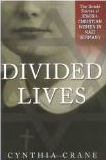
 |
Divided Lives The Untold Stories of Jewish-Christian Women in Nazi Germany |
by Cynthia Crane
![]()
Every time history repeats itself, the price goes up. -- Unknown
History is perceived differently from country to country and from generation to generation. History is not static and diachronic. In my book Divided Lives, many of the women that I interviewed claim to discuss German history as the Germans perceive it and tell it.
The stories of the Mischling women in Divided Lives -- Hecht, Wecker, Yost, Wilmschen, Lorenzen, Randt, Ilse B., Wetzel, and Bosselmann -- display vividly the trauma these women endured during and after the Third Reich, and the coping mechanisms they sought after or adopted. Wilmschen's, Wetzel's, Bierstedt's, and Bosselmann's mothers were deported to camps. Yost's and Randt's fathers escaped Germany, Gretel Lorenzen's father was deported to a camp, Wecker's father was killed by the Nazis, and Hecht's was purportedly exterminated in Auschwitz.
Many of the women experienced trauma symptoms that did not necessarily dissipate once they had "purged" their memories. As Laub says -- The traumatic event, although real, took place outside the parameters of "normal" reality, such as causality, sequence, place and time. The trauma is thus an event that has no beginning, no ending, no before, no during and no after. This absence of categories that define it lends it a quality of "otherness," a salience, a timelessness and a ubiquity that puts it outside the range of associatively linked experiences, outside the range of comprehension, of recounting and of mastery. Trauma survivors live not with memories of the past, but with an event that could not and did not proceed through to its completion, has no ending, attained no closure, and therefore, as far as its survivors are concerned, continues into the present and is current in every respect.
Hence, the women repeatedly commented, "I can't describe this," and "you can't imagine" as they attempted to narrate their past lives in the present. They could not escape the fact that they were victims at one time, that the people with whom they lived had been their persecutors. This problem is seen also in the United States, such as with African Americans and Native Americans. It would seem a difficult thing for anyone to live peacefully among her tormenters. This problem exists in many other nations. South Africa, Argentina, and other states have collapsed and been renewed under somewhat less authoritarian conditions. There is a lot of bitterness and inability to forget. We must look at the Mid-East, the Balkans, Rwanda/Botswana and other regions where these hatreds continue for generations and generations. Perhaps it is just part of the human condition -- not really a disease that can be "healed," or a trauma that can be "purged."
The issues that the Mischling women faced can be bridged to the present in America. In a country verging sometimes on amorality, very often pushed by the media, we grasp at techniques such as dehumanization, stereotypes, and violence to talk about or act against "enemies." Do the same fears still predominate in human nature, those of needing to exterminate for racial cleansing, and the fear of the unknown?
History is difficult to escape. These Mischling women have little, if any, support in Germany today. Silence is preferable to talking to the "wrong" person about their background. Perhaps this is why they still struggle to one degree or another with their identities. Most Mischlinge who survived do not have support within the Jüdische Gemeinde (Jewish community). The "mixed" women are still "mixed" psychologically and socially. They rarely and cautiously reveal their heritage or their former outcast status so as not to draw attention to themselves. Often they have not disclosed their past to children or grandchildren. For the most part, they want to be included in German society and not be seen as women who were once considered "inferior" or "outsiders" by the majority.
Even though now they can speak about their past, they protect their current status. Few of the women had ever spoken, and had not disclosed their identity split between Jew and Christian. To the outside world, they were Germans. What these women discuss can be viewed as a warning to other cultures. We see what transpires from racist fanaticism and fascism. Through these women's narratives we not only can better understand women's plight under authorized persecution, but also the personal, individual traumas they withstood in regard to self, parents, lovers, husbands, children, and career.
During the era of National Socialism, women more than men tended to be attached to community life, and they were more aware of their disintegrating world. Women also were expected to remain at home to care for parents and siblings, whereas men were more mobile and able (by virtue of their gender) to hide or emigrate. Because these women lived in constant turmoil, with relationships shifting so dramatically, they had to escape from their lives, essentially, from their selves, in some manner -- physically, psychologically, or both. Many academics, including Raul Hilberg, argued that discrimination against the Mischlinge was not severe. However, the narratives that make up my book dispute such historical suppositions. As Büttner claims, "Reports of those involved give another picture of the persecution of that time. That is why a new look at this subject is necessary."
![]()
Cynthia Crane is Assistant Professor of English at The University of Cincinnati's Raymond Walters College in Cincinnati, OH. She is also a speaker and lecturer. Among her awards are a J. William Fulbright Scholarship, a P.E.O. National Scholar's Award, and a URC University of Cincinnati Research Grant. Her poetry and non-fiction have appeared in various publications. www.dividedlives.com Purchase now from Amazon.com - Divided Lives : The Untold Stories of Jewish-Christian Women in Nazi Germany by Cynthia A. Crane.
Return to The History Place - Selected Books on Hitler's Germany
The History Place thanks all of our visitors who have purchased books!
See also: The History Place selection of |
![]()
[ The History Place Main Page | American Revolution | Abraham Lincoln | U.S. Civil War | Child Labor in America 1908-1912 | U.S. in World War II in the Pacific | John F. Kennedy Photo History | Vietnam War | The Rise of Adolf Hitler | Triumph of Hitler | Defeat of Hitler | Timeline of World War II in Europe | Holocaust Timeline | Photo of the Week | This Month in History ]
Copyright © 2025 The History Place™ All Rights Reserved
Terms of use: Private home/school non-commercial, non-Internet re-usage only is allowed of any text, graphics, photos, audio clips, other electronic files or materials from The History Place.
